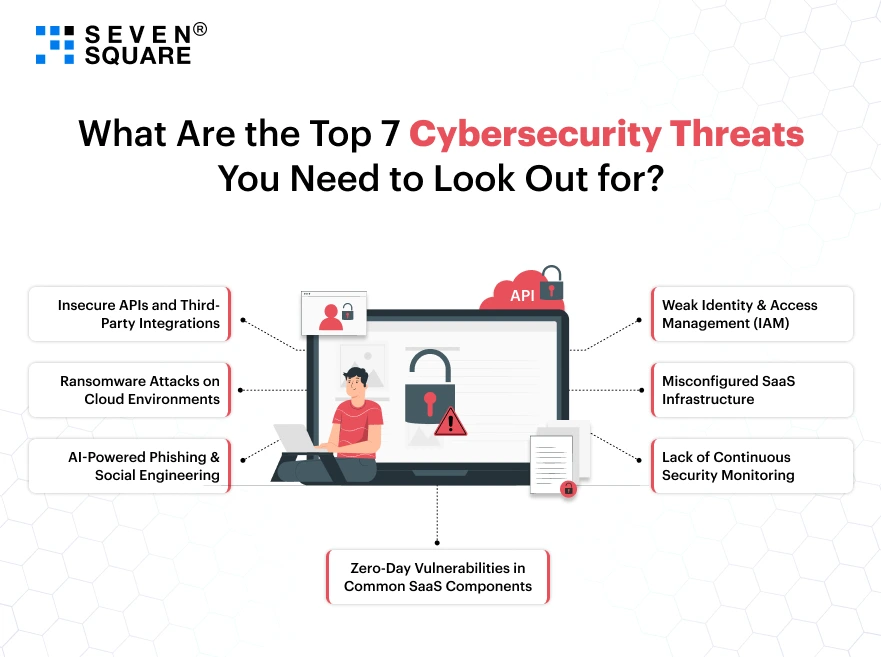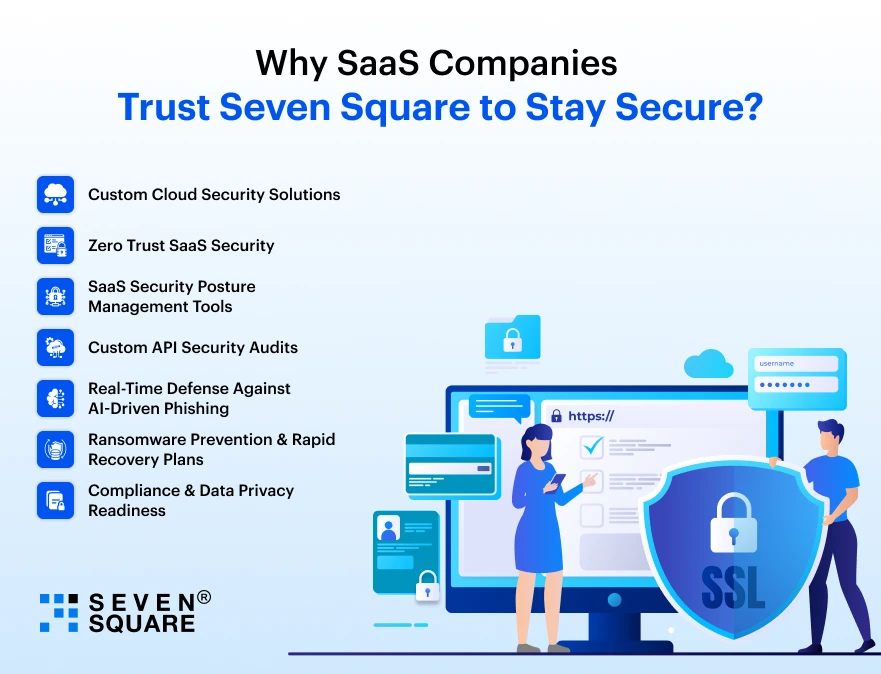Today, Software-as-a-service (SaaS) platforms are being used by everyone.
These SaaS platforms are sometimes vulnerable to cyber threats.
Imagine this: You’re the founder of a growing SaaS startup.
One day, a client reports suspicious account activity. You dig in, and within hours, it turns into a nightmare as a compromised API endpoint leaks customer data.
Just like that, your team is trying to resolve it, your trust score reduces, and churn risk increases. Sounds familiar?
This isn’t a worst-case scenario. This is what we see every month across industries.
Our developers worked with SaaS companies in healthcare, logistics, finance, and retail, helping them build or rebuild secure cloud-native platforms.
While developing, we ensure that your SaaS has the best design & it won’t be affected by cybersecurity threats.
In this blog, we will try to explore the top 7 cybersecurity threats SaaS companies must watch in 2025, and more importantly, what to do about them.
What Are the Top 7 Cybersecurity Threats You Need to Look Out for?

In 2025, cybersecurity threats targeting SaaS companies are more sophisticated than ever.
From ransomware SaaS attacks to insecure APIs, the threat landscape demands constant vigilance.
Whether you’re a founder or CTO, understanding these top SaaS cybersecurity risks, including zero trust SaaS security, cloud security solutions, and AI-driven phishing threats, is important to protect your users, data, and long-term trust.
Here’s what to look out for:
1. Insecure APIs and Third-Party Integrations
SaaS apps are only as secure as their weakest endpoint. APIs are goldmines for attackers, especially when authentication or rate-limiting is weak.
In 2025, API vulnerabilities are growing thanks to microservice overload and rushed releases.
With so many third-party services integrated (think CRMs, billing tools, analytics), most teams don’t fully vet every dependency.
How to defend:
- Implement API gateways with throttling and anomaly detection.
- Use OAuth2 and strict token expiration.
- Monitor every API call & yes, even the boring ones.
- Adopt SaaS security posture management tools to scan for exposure.
At Seven Square, we helped a fintech startup to reduce API attack surface by 40% using scoped tokens and automated endpoint scanning.
Learn to integrate GPT-4 or Claude AI in Your SaaS .
2. Ransomware Attacks on Cloud Environments
Think ransomware is just a file-locking desktop menace? Think again. SaaS platforms are now major ransomware targets.
Attackers exploit misconfigured cloud security solutions, steal admin credentials, and encrypt backend storage or data warehouses.
Ransomware SaaS incidents rose 73% in 2025, especially among smaller startups using public cloud services without zero-trust policies.
How to defend:
- Regularly back up data in a separate cloud region.
- Use IAM best practices (least privilege, MFA).
- Deploy real-time threat detection in your CI/CD pipeline.
- Lock down secrets in a secrets manager (not ENV files).
We worked with a B2B SaaS CRM platform to simulate ransomware drills and redesigned their backup architecture.
They can now recover from breaches within 45 minutes, not 2 days.
3. AI-Powered Phishing & Social Engineering
2025 brings more than deepfakes and chatbots; we’re seeing AI-driven phishing threats where attackers clone your support voice, mimic writing styles, or automate fake admin requests.
It is one of the latest cyber threats that you need to look out for.
Founders, PMs, and even developers are tricked into clicking malicious links or sharing credentials.
This isn’t just a people problem; it’s a SaaS compliance data privacy 2025 issue.
How to defend:
- Train your team on new-age phishing tactics.
- Use zero-trust SaaS security principles: never trust, always verify.
- Add anomaly-based email filtering with AI.
- Enforce MFA (not just SMS-based).
We provided cloud security solutions & helped a healthcare SaaS provider to reduce phishing response time using behavior-based alerts, cutting potential damage by 80%.
4. Zero-Day Vulnerabilities in Common SaaS Components
From JavaScript libraries to identity providers like Microsoft Entra ID, vulnerabilities are discovered faster than most teams can patch.
In 2025, we’re seeing attackers exploit zero-days within hours of disclosure.
The latest Entra ID MFA bypass required barely any effort but enabled full account takeovers.
How to defend:
- Set up automatic patch alerts for all third-party tools.
- Run real-time scanning tools in CI/CD.
- Subscribe to CVE feeds and automate ticket creation.
- Avoid outdated libraries and excessive dependencies.
Our SaaS clients often thank us for proactively removing insecure packages before vulnerabilities even hit the news cycle & they are safe against cyber threats.
5. Weak Identity & Access Management (IAM)
Cloud security fails when users have too many privileges.
Overprovisioned roles, shared credentials, and expired sessions make your platform a soft target.
With growing user bases, multi-device user sessions, and SSO configurations become attack vectors. One leaked token = full admin access.
How to defend:
- Apply zero trust for SaaS companies.
- Enforce RBAC (role-based access control).
- Rotate credentials and auto-expire sessions.
- Add device fingerprinting for critical actions.
We helped a legal-tech SaaS firm implement RBAC across three tiers, eliminating 92% of unnecessary access paths.
6. Misconfigured SaaS Infrastructure
Sometimes, it’s not malware, it’s a misconfigured S3 bucket, open port, or unrestricted admin panel.
One retail SaaS platform we audited had a staging URL indexed on Google, open to anyone. That’s not just careless, that’s catastrophic.
How to defend:
- Run automated infrastructure audits monthly.
- Hide non-prod environments behind VPN or IP restrictions.
- Use SaaS security posture management tools to catch drift.
- Regularly review CI/CD permissions and GitHub Actions.
These quick wins saved one of our logistics SaaS clients from accidentally exposing shipment data tied to government partners.
7. Lack of Continuous Security Monitoring
You can’t fix what you don’t know. Without live monitoring, anomaly detection, and real-time alerts, attackers have free rein.
2025 is all about continuous exposure management. It’s not a product. It’s a mindset shift. SaaS founders need to think like attackers to defend effectively.
How to defend:
- Set up alerting based on behavioral changes, not just signatures.
- Use cloud-native SIEMs (Security Info and Event Management).
- Hire a partner who understands both engineering and product risk.
Why SaaS Companies Trust Seven Square to Stay Secure?

At Seven Square, we understand that modern SaaS companies face a complex and ever-changing set of cybersecurity threats.
From insecure APIs to AI-driven phishing threats, and from ransomware SaaS attacks to zero-day vulnerabilities, the risks aren’t slowing down, and neither are we.
Here’s what makes us different:
- Custom Cloud Security Solutions: We build scalable and secure architectures that protect your SaaS from the inside out, backups, CI/CD pipelines, and cloud access controls included.
- Zero Trust SaaS Security: Our engineers implement strict identity and access management (IAM) practices, role-based access, and device-based authentication to minimize risk.
- SaaS Security Posture Management Tools: We continuously monitor your platform for vulnerabilities, misconfigurations, and exposure across APIs and infrastructure.
- Custom API Security Audits: We prevent API vulnerabilities with smart tokenization, rate-limiting, and OAuth2 integration.
- Real-Time Defense Against AI-Driven Phishing: Through behavior-based alerting and AI monitoring, we help you stop social engineering before it starts.
- Ransomware Prevention & Rapid Recovery Plans: Our proven playbooks and cloud redundancy setups drastically reduce downtime and damage.
- Compliance & Data Privacy Readiness: We help ensure your SaaS product meets 2025’s toughest SaaS compliance data privacy standards.
Need a SaaS security audit? Contact Us Now!
SaaS Security Isn’t a One-Time Setup: It’s a Living System
You don’t secure your SaaS once and call it done. As your codebase, users, and integrations grow, so do your cyber threats.
Founders and product managers, this isn’t just an IT problem. It’s a business risk.
Learn about top AI features that SaaS product needs.
When security fails, trust dies, and trust is your product.
Think Like an Attacker, Build Like a Leader
You can’t prevent every breach. But you can reduce risk, recover faster, and stay worthy of your users’ trust.
Don’t wait until you’re in the news. The best SaaS teams in 2025 are not just building fast. They’re building smart.
If you want to protect your SaaS platform from the top cybersecurity threats, start with your APIs, IAM, and infrastructure. Secure the core, and the rest gets easier.
FAQs
- The top cybersecurity threats SaaS companies face in 2025 include insecure APIs, ransomware attacks, AI-driven phishing, misconfigured cloud infrastructure, and weak IAM (identity and access management).
- Proactive SaaS security posture management is essential to stay protected.
- To prevent ransomware in SaaS, use multi-region backups, enforce least-privilege access, and integrate real-time cloud security solutions.
- Also, implement zero-trust SaaS security policies to block unauthorized users.
- Using SaaS security posture management tools helps detect open ports, exposed S3 buckets, or unprotected endpoints.
- Regular cloud audits and automated scanning reduce risks tied to human error.
- Use token rotation, session expiration, and device fingerprinting.
- Implementing robust IAM with MFA and geo-aware login alerts ensures secure multi-device session management in SaaS platforms.